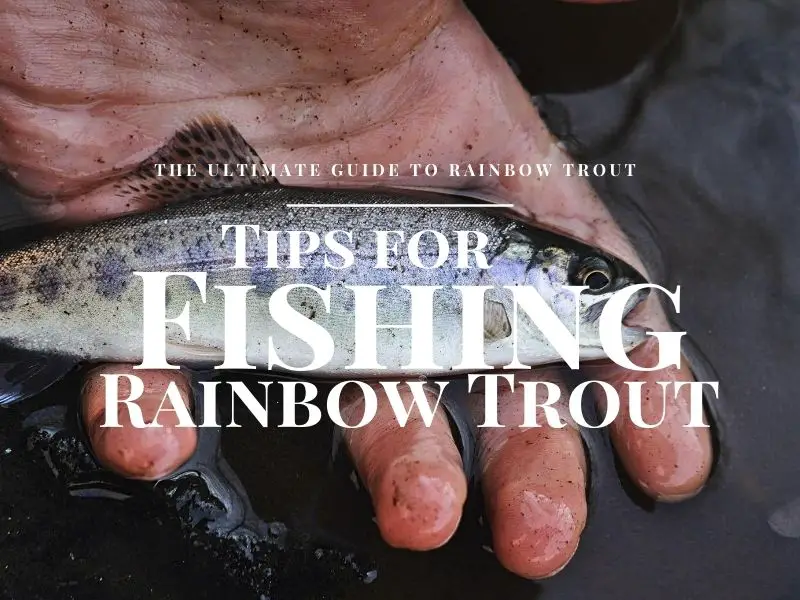Rainbow trout are a popular game fish found throughout tributary rivers of the Pacific Ocean. They can live in saltwater and freshwater, with certain species like the steelhead who spawn in freshwater after living in the ocean for a few years. They have also been stocked throughout many rivers and lakes.
Trout fishing is extremely popular due to the abundance of the species. Forms of rainbow currently exist in over 45 countries throughout the world. They are fished for sport and for food across the globe. Many anglers also love the delicate flavor of trout.
We created these rainbow trout fishing tips to help you learn about the species and improve your ability to catch them.
In this guide, we will cover the different types of rainbow species, their seasonal and weather patterns, the food they eat, the equipment you will need to catch them, and a few other additional tips.
By the end of this, you will have learned how to catch rainbow trout. The rest is up to you.
Types of Rainbow Trout
The scientific name of the rainbow is Oncorhynchus mykiss. There are several different common subspecies of rainbows.
Coastal Rainbow Trout
From the tributary rivers of the Pacific Ocean in Alaska all the way down to southern California you will find these coastal rainbow fish.
There are freshwater forms of coastal trout, and anadromous forms which are called steelheads. Steelhead trout tend to live in the ocean for a few years before returning to freshwater to spawn.
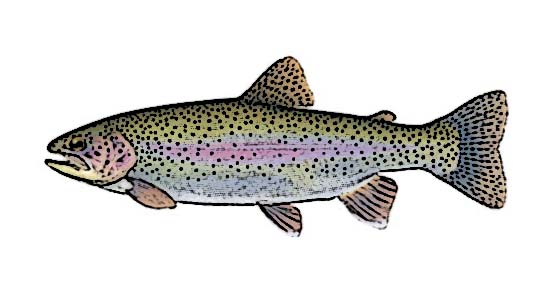
Coastal rainbow trout have a lot of variability in terms of body shape and color. Adult fish are commonly silver and heavy small black dots with heavy spots. They have a pink or red lateral band. Steelhead trout are often a silver-blue color and quite large in size.
Redband Trout
There are three kinds of redband trout. The Columbia River redband trout, the Mccloud River redband trout, and the Great Basin redband trout. These are all subspecies of rainbow. The anadromous forms of redband trout are called redband steelhead.
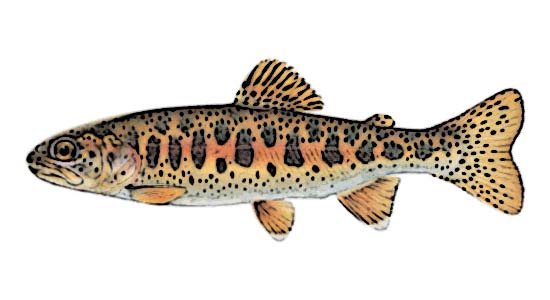
In appearance, redband look pretty similar to coastal rainbows but generally, they have larger spots that are rounded. They also have an orange-red lateral band, whereas the coastal trout have a pink-red lateral band. They can also be identified by their white tips on their dorsal, anal and pectoral fins
Kern River Golden Trout
The kern river golden trout is another subspecies of the rainbow that live in the Kern River and it’s tributary rivers in California. There are three subspecies that are very similar: the golden trout, kern river rainbow, and little kern golden trout.
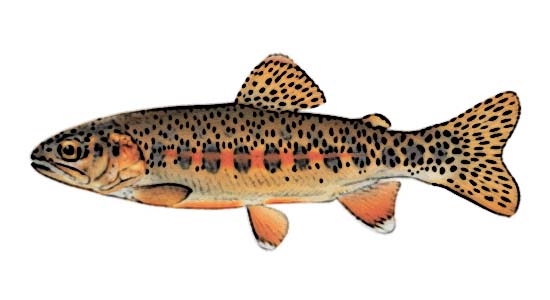
Golden trout can be identified by their gold-colored flank with red horizontal bands and dark oval marks on each side of the fish. They also have white-tipped lateral, dorsal, and anal fins.
How Big Do Rainbows Get?
Freshwater rainbow that live in rivers weigh an average of between 1 to 5 pounds. The forms like steelhead that live in oceans for years and return to lakes to spawn can reach upwards of 20lbs, which is significantly larger than the fish that live their whole lives in freshwater.
Some can grow to giant proportions. The world record measured approximately 42 inches and weighed in at a whopping 48 pounds. This one was caught in Canada.
Where Do Rainbow Live?
They can be found on every continent except Antarctica. Globally the exist in 45 countries. They are extremely common throughout the U.S., from southern Alaska down to California and throughout the Great Lakes Region. They have been introduced to most states in the United States.
Where To Catch Rainbows?
Knowing how to find the fish in the body of water you are fishing can greatly increase your chance of catching one. Here we will cover where to find the fish depending on if you are fishing a lake, river, or stocked pond.
Catching Trout in Lakes
When fishing in a lake, look for cooler parts of the lake with deeper waters.
You can have a lot of success fishing near ledges and dropoffs. Another good strategy to locate the them is to find the vegetation where smaller baitfish might be feeding.
Try to understand the feeding habits of the baitfish in the water you are fishing. If you find where the fish are feeding, you find the fish.
Catching Trout in Rivers
Rivers and streams are excellent places to catch rainbow trout. If you’re fishing in a river, look for moving water water with fast currents.
You can commonly find trout near fallen trees, large rocks, and other structure. They will also be feeding on schools of baitfish and insects in water that is less than 10 feet deep.
Catching Trout in Ponds
If you’re fishing a stocked pond for rainbows, you want to understand the pattern of the trout.
Freshly stocked trout are known to swim together in a circular pattern and stay pretty close to where they were placed in the water. After they’ve settled in look for deeper cooler parts of the water. You can also find them near fallen trees, rocks, docks, and other structures.
What Do They Eat?
If you find what the rainbow are feeding on, you find the fish. You’ve probably heard that saying before in one way or another. Rainbow trout have a wide variety in their diet.
They commonly eat larval, pupal, insects such as caddisflies, stoneflies, mayflies, ants, grasshoppers, crickets. They also eat smaller fish, crayfish, shrimp, and fish eggs like salmon eggs, brown trout eggs, cutthroat trout eggs, and more. They will basically eat almost anything they can find.
Trout Seasonal Patterns
You may be wondering when the best season for catching rainbow is. Well, the truth is, they can be caught almost any time of year, as long as you understand their behavior.
Spring
In early spring your best bet will be fishing for trout in the shallows as the water starts to warm. Look for them in shoal zones and water that is less than 10 feet deep.
Rainbow typically spawn in late spring to early summer. During this time you can commonly find them in stream riffles downstream from pools. Fishing during the spawning season is a very popular way to catch a lot of fish because of their activity and energy level.
Summer
In the summer when the water starts to heat up, you can find the rainbows in deeper cooler sections of the water. They are known to be active early in the morning, in the evening and night when the sunlight isn’t pushing them into the deeper sections. You can commonly find them in the top 10 feet of water during this time.
By midsummer when the water is at its hottest, you’ll have to look for them in the deeper sections. They tend to become more sluggish and will very rarely come out to feed.
Another great option is to find the thermocline and fish that area. A thermocline is a layer of water below warm water that has a drastic drop in temperature.
They develop in most lakes, ponds, and reservoirs if you’re fishing in the western region.. It is usually a hotbed for trout activity. Thermoclines don’t really develop until midsummer though.
If you’re trying to locate the thermocline, sometimes officials take readings and make the findings public. Otherwise, you can read fishing reports, or ask more experienced anglers. Some high end fish finders can also detect this area.
Inlets, springs, and upwelling sites are also great spots to fish for rainbow trout in the summer. These areas tend to be oxygen-rich and cool environments that attract plenty of baitfish.
Fall
Autumn is not a very popular time to fish for trout, though it can be done if you know where to look. At the beginning of fall, the surface water tends to be warm, which pushes the fish towards the bottom where its cooler. Bottom fishing during this time is your best bet.
As the water cools you can then start to find them throughout the waters feeding on baitfish and insects.
Winter
During the winter you can find them in relatively shallow water. Look around for shallow weedy bays, coves, and inlets where the water is less than 5 feet deep. In waters around 10 feet deep, rainbow trout are known to feed near the middle column of the water.
If you’re fishing in a lake, look for the lakes most shallow fertile section. If you can find a weedy area, there’s probably a bunch of rainbows in the area. If there are no fertile section of the lake that are full of weeds, look for a flat shallow section to do your fishing.
Read the full guide on ice fishing rainbow trout.
Fishing Equipment
Now that you’ve learned a little bit about trout and their seasonal patterns, it’s time to cover the gear you will need to start catching them successfully. In this section, we will cover the kinds of rods, reels, bait, hooks, fishing line, and other tools you will need for your next trout fishing journey.
Rods and Reels
Generally for fishing rainbow, most anglers will use either a spinning rod and reel or a fly rod. For a spinning rod, we recommend an ultra-light rod around 6 to 6.5 feet in length. Read our full guide on the best spinning rods for trout.
If you’re new to fishing it’s important to understand how length affects the performance of the rod. Longer rods can cast longer distances, but shorter rods have less bend and are better at fighting fish.
We recommend around the 6 feet mark because it’s a good balance between casting distance and accuracy. If you’re already an experienced angler and know your rainbow trout fishing spot really well, you can disregard this advice.
Fly fishing for trout is extremely popular. If you intend to use a fly rod we recommend something slow to medium action around 7.5 to 8 feet. If you’re already an expert angler and you know your rainbow fishing spot requires you to cast long distances than you may want something longer, but this is a good all-round length for most situations.
Lures and Bait
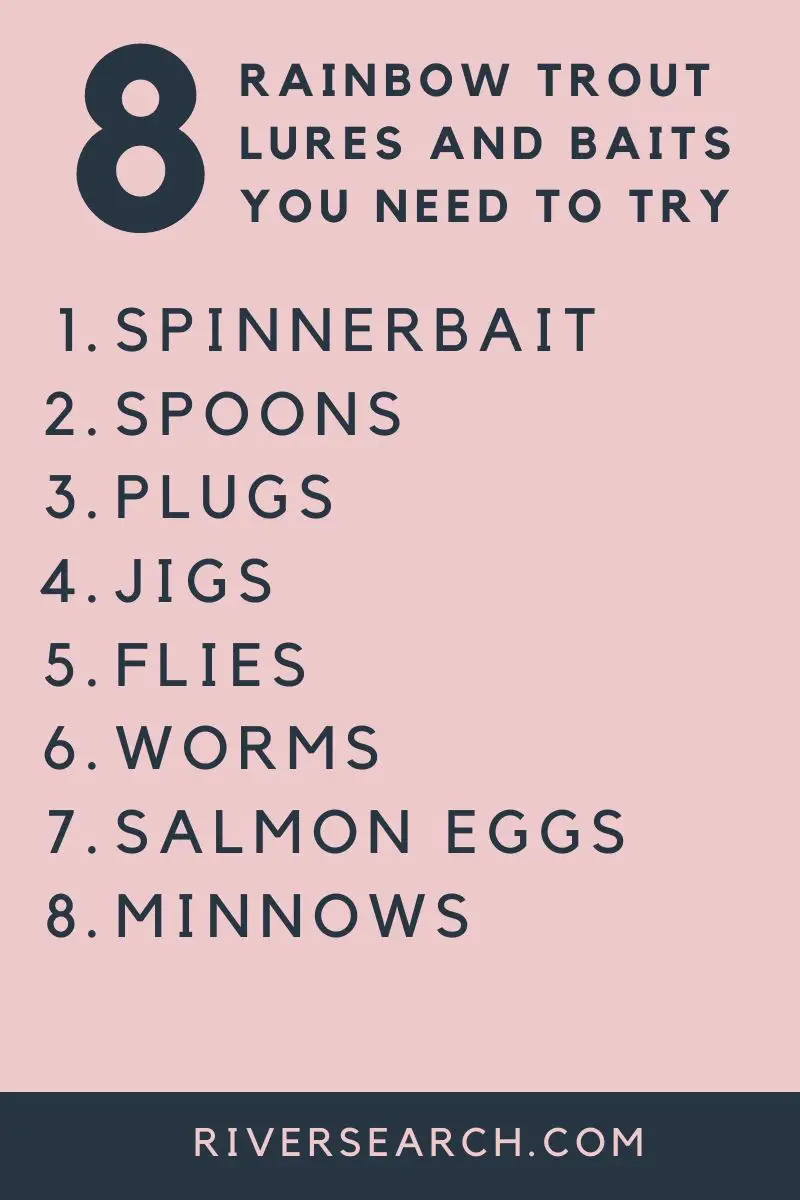
Spinnerbait
Spinners work well when the fish are hungry and likely to chase after their food. You can have a lot of success in the summer using a good spinnerbait. Cast or troll them when the fish come out to feed in the early mornings or evenings. A steady retrieve usually works pretty well, but you can always experiment.
Spoon Lures
Another great option when the fish are hungry is a good spoon lure. Spoons are very versatile and can be used in a variety of different conditions. Look for one that has a little bit of an erratic action to entice hungry rainbows. Try a steady retrieve, but don’t be afraid to mix it up and see what works best in the waters you are fishing.
Plugs
Fishing for rainbow with a good plug can also be effective. These are good when the warmer water forces the trout into the deeper cooler sections of the water.
Try a plug between 2 to 4 inches long. If you’re trolling the basic recommendation for trout is at about 2.5 to 3.5 miles per hour. You may need to switch colors and sizes of your plug if the one you are currently using isn’t being effective.
Jigs
Jigs are versatile and can be used effectively to catch rainbows in a number of ways. They can be fished in shallow water, deep water. They can be fished fast or slow. There is also a wide variety of colors and materials they can be made from that may be appealing to trout.
Marabou Jigs are commonly used for rainbow trout fishing. These are used to imitate nymphs or other small baitfish. Soft plastic jigs have also been known to be effective.
If you’ve never fished with a jig before, it takes a little bit of experience to get down. A common method for fishing rainbows with a jig is to use it with a float. You can also cast it a twitch the rod which can make the jig attractive to trout in the area.
If the trout are in deeper sections of water you can bounce the jig of the bottom. This usually works when trout are avoiding the top warm sections of the water.
Flies
The fly that works best for rainbow trout can vary a lot by the season. Match the hatch is always relevant so it may be best to figure out what sort of fly is common in the areas you are going to be fishing. In general, though vibrant patterns tend to work well. Blob flies and buzzer flies are always a good choice.
In many areas rainbow trout commonly feed on nymphs so a good nymph fly can be a great way to attract fish. If you’re new to fly fishing you can check out this great guide on fly fishing for rainbow trout.
Worms
The classic worm is always a productive way to catch fish. You can use nightcrawlers, waxworms, and mealworms to catch rainbows.
Our personal favorite is the nightcrawler. These can be used in almost any season in a variety of different waters. You can use them in slow-moving rivers or lakes.
Use them in the spring casting it from shore. You can use a slip sinker for weight or troll it with a cowbell. In the fall bottom fishing with nightcrawlers is a good option. They can also be quite productive in summer casting them from shore.
We recommend inflating your nightcrawler. This helps them float and will attract more trout by giving the worm a more lifelike appearance.
Salmon Eggs
When river fishing for rainbows, the salmon egg is a tried and true bait that is favorited by many anglers. Use a single egg with a small bobber and cast it upstream from the zones where the fish may be. As soon as you feel any odd movement, set your hook.
Salmon eggs are very effective because the trout have been eating them for many generations. These days you can even find hooks specifically designed for salmon eggs, so that may be something to look into if you’re fishing a river.
Minnows
Minnows can work almost any time of year, though they shine particularly well in winter months. Try using them slightly below the ice and adjust your depth until you get a few strikes. Using a small jig tipped with a minnow is a very productive presentation.
Fishing Line
If you’re fishing in clear water a clear mono line can work wonders. If the water is off-color you may want a bluish or greenish color. Generally, for trout fishing most anglers will say to use the lightest light that you can possibly use. We recommend a 6lb test mono line.
Fluorocarbon line is another good option. Rainbow are known to have pretty good vision. So using a good fluorocarbon line which is nearly invisible underwater helps for fish that are easily spooked by line. Read our full guide on the best trout fishing line.
Hooks
For trout, we always recommend a single hook. The hook size that works best for rainbow can vary depending on the size of the trout and the waters you are fishing.
As we discussed earlier, trout tend to have pretty good vision, so a hook can spook them in really clear waters. If you’re fishing crystal clear lakes look for a smaller hook around size #10. In most other situations something around a #6 to #8 hook is good. For particularly large trout you may want to use a size #4 to #2.
Other Tools and Equipment
If you’re fly fishing you may need waders and wading boots. You need to have room to backcast which sometimes will require you to get in the water. Look for something breathable that will keep you warm if the water is cold.
Another great option is a landing net. Since you usually fish for rainbows with a lighter line, having a good landing net is essential.
Trout are known for having a protective slime on their body, so if you are going to catch and release you need a net that will not harm them. Thin-mesh nets are known for harming the fish. These days you can find rubber trout nets which should work fine.
You may also want a good pair of forceps or hemostats to quickly unhook trout. Trout have teeth which can make unhooking a little bit difficult without a good tool.
Tips To Help You Catch More Rainbow Trout
Match Your Bait Size To The Trout’s Mouth
Rainbow have smaller mouths than other kinds of trout. If your bait is too big, the fish are not likely to bite. Sometimes you have to use a smaller bait. Try smaller worms or half a nightcrawler if your baits are larger than their mouths.
Keep Your Presentation Sneaky
Trout are known for having good vision. So you need to plan for this with the way you present your bait. Try to hide most of the hook so that it barely shows. Large obtrusive hooks might spook the trout.
The same thing goes with your fishing line. Most anglers when fishing trout will try to use the thinnest line they can get away with. This is because a thick line might scare away the fish.
Lastly, this rule should also guide the bobber you are using. Choose one with a lighter color on the bottom side so that it doesn’t stick out and scare away the trout.
Match the Hatch
Whenever you are fishing match the hatch is always relevant. It’s as true for trout as it is any other fish.
If you’re fishing in a river, salmon eggs can be a powerful bait because rainbow are so used to eating them. In other situations, insects or lures that mimic nymphs can be a good option. Trying to get a feel for what the fish regularly feed on in the waters you will be fishing, and find a good lure that resembles that.
FAQ – Commonly Asked Questions
This section will answer other commonly asked questions you may have regarding trout.
Can They Live in Saltwater?
Yes. Steelhead trout are the same species are rainbow. Steelhead live in saltwater for 2-3 years at a time, and return to freshwater for spawning.
When are Rainbow in Season?
Ultimately this completely depends on the area you are fishing. You will have to check with your local DNR on the season for the rainbowin your local waters.
Can They See Color?
Trout are known for having color vision but usually only in clear waters and short distances. There also has to be good light for them to see color. If it’s dawn, dusk, or night, they do not see very well.
Do They Have Teeth?
Rainbow do have teeth on the roof of the mouth. This one of the reasons fishing with a tool to help remove the hook may come in handy.
What Do They Taste Like?
Rainbow trout is known for being flaky, soft and tender with a mild nut-like flavor. You will have to check on the fishing regulations in your area. Some areas trout are for catch and release fishing only and you are not allowed to keep them to eat.
What Eats Rainbow Trout?
Humans are one of the main predators of larger rainbow. Smaller ones are commonly eaten by smallmouth bass, larger trout, kingfishers, herons, eagles, osprey, otters, and raccoons.
